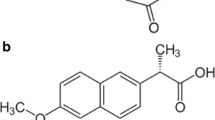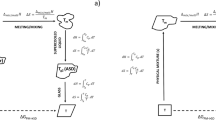Purpose
The impact of excess solids on the apparent solubility is examined.
Methods
The apparent solubility of some model drugs was measured in various buffered solutions, with various amounts of excess solid. To help understand the dependence of the solubility on the amount of solid, we evaluated the dissolution and crystallization rates of indomethacin (IDM), one of the model drugs, at near-equilibrium conditions.
Results
In the case of IDM, the apparent solubility decreased with an increase in the solid amount at pH 5 and 6. On the other hand, it increased with an increase in the solid amount at pH 6.5 and 7. The crystallization and dissolution rates of IDM decreased and increased, respectively, with an increase in pH values, and became equal at between pH 6 and 7. Therefore, the apparent solubility was most likely to be affected by the balance between the crystallization and dissolution rates. The apparent solubility of other model drugs showed the same trend, although the dependency on the solid amount was not as significant as in the case of IDM.
Conclusions
The apparent solubility was affected by the amount of solid for all the model drugs investigated. This was most likely to be caused by a competition between the crystallization and dissolution rates.







Similar content being viewed by others
References
L. Pan Q. Ho K. Tsutsui L. Takahashi (2001) ArticleTitleComparison of chromatographic and spectroscopic methods used to rank compounds for aqueous solubility J. Pharm. Sci. 90 521–529 Occurrence Handle10.1002/1520-6017(200104)90:4<521::AID-JPS1009>3.0.CO;2-B Occurrence Handle11170041
E. H. Kerns (2001) ArticleTitleHigh throughput physicochemical profiling for drug discovery J. Pharm. Sci. 90 1838–1858 Occurrence Handle10.1002/jps.1134 Occurrence Handle11745742
W. L. Jorgensen E. M. Duffy (2002) ArticleTitlePrediction of drug solubility from structure Adv. Drug Deliv. Rev. 54 355–366 Occurrence Handle10.1016/S0169-409X(02)00008-X Occurrence Handle11922952
D. J. W. Grant H. G. Brittain (1995) Solubility of pharmaceutical solids H. G. Brittain (Eds) Physical Characterization of Pharmaceutical Solids Marcel Dekker New York 321–386
S. H. Yalkowsky Y. He (2003) Handbook of Aqueous Solubility Data CRC Press Boca Raton
P. Taylor (1998) ArticleTitleOstwald ripening in emulsions Adv. Colloid Interface Sci. 75 107–163 Occurrence Handle10.1016/S0001-8686(98)00035-9
R. H. Müller C. Jacobs O. Kayser (2001) ArticleTitleNanosuspensions as particulate drug formulations in therapy. Rationale for development and what can expect for the future Adv. Drug Deliv. Rev. 47 3–19 Occurrence Handle10.1016/S0169-409X(00)00118-6 Occurrence Handle11251242
Z. Wang L. S. Burrell W. J. Lambert (2002) ArticleTitleSolubility of E2050 at various pH: a case in which apparent solubility is affected by the amount of excess solid J. Pharm. Sci. 91 1445–1455 Occurrence Handle10.1002/jps.10107 Occurrence Handle12115844
M. Otsuka T. Matsumoto N. Kaneniwa (1986) ArticleTitleEffect of environmental temperature on polymorphic solid-state transformation of indomethacin during grinding Chem. Pharm. Bull. 34 1784–1793 Occurrence Handle3719878
K. J. Crowley G. Zografi (2002) ArticleTitleCryogenic grinding of indomethacin polymorphs and solvates: assessment of amorphous phase formation and amorphous phase physical stability J. Pharm. Sci. 91 492–507 Occurrence Handle10.1002/jps.10028 Occurrence Handle11835208
S. Chakrabarti R. Severen Particlevan P. Braeckman (1978) ArticleTitleStudies on the crystalline form of phenytoin Pharmazie 33 338 Occurrence Handle684047
K. Kawakami Y. Ida (2005) ArticleTitleApplication of modulated-temperature DSC to the analysis of enantiotropically-related polymorphic transitions Thermochim. Acta 427 93–99 Occurrence Handle10.1016/j.tca.2004.08.019
R. Tang G. H. Nancollas (2000) ArticleTitleAbnormal dissolution of octacalcium phosphate crystals at constant undersaturation J. Cryst. Growth 212 261–269 Occurrence Handle10.1016/S0022-0248(00)00022-1
M. G. Orkoula P. G. Koutsoukos (2002) ArticleTitleVariability of dissolution rates at constant undersaturation J. Colloid Interface Sci. 253 185–189 Occurrence Handle10.1006/jcis.2002.8536
K. Kawakami K. Miyoshi Y. Ida (2004) ArticleTitleSolubilization behavior of poorly soluble drugs with combined use of Gelucire 44/14 and cosolvent J. Pharm. Sci. 93 1471–1479 Occurrence Handle10.1002/jps.20067 Occurrence Handle15124205
G. L. Zipp N. Rodríguez-Hornedo (1992) ArticleTitlePhenytoin crystal growth rates in the presence of phosphate and chloride ions J. Cryst. Growth 123 247–254 Occurrence Handle10.1016/0022-0248(92)90030-M
D. Lechuga-Ballesteros N. Rodríguez-Hornedo (1993) ArticleTitleThe relation between adsorption of additives and crystal growth rate of l-alanine J. Colloid Interface Sci. 157 147–153 Occurrence Handle10.1006/jcis.1993.1169
I. H. Leubner (2000) ArticleTitleParticle nucleation and growth models Curr. Opin. Colloid Interface Sci. 5 151–159 Occurrence Handle10.1016/S1359-0294(00)00048-0
R. Mohan A. S. Myerson (2002) ArticleTitleGrowth kinetics: a thermodynamic approach Chem. Eng. Sci. 57 4277–4285 Occurrence Handle10.1016/S0009-2509(02)00344-5
A. T. Florence D. Attwood (1998) Physicochemical Principles of Pharmacy EditionNumber3 Palgrave New York 84–85
Author information
Authors and Affiliations
Corresponding author
Rights and permissions
About this article
Cite this article
Kawakami, K., Miyoshi, K. & Ida, Y. Impact of the Amount of Excess Solids on Apparent Solubility. Pharm Res 22, 1537–1543 (2005). https://doi.org/10.1007/s11095-005-6247-7
Received:
Accepted:
Published:
Issue Date:
DOI: https://doi.org/10.1007/s11095-005-6247-7




